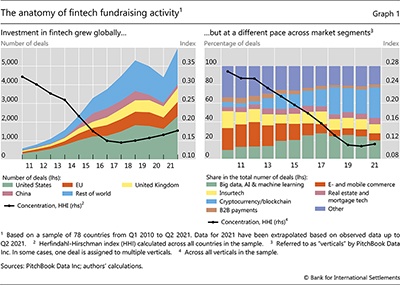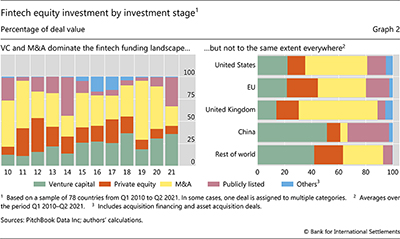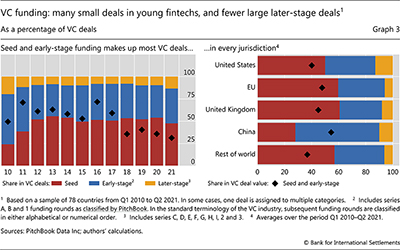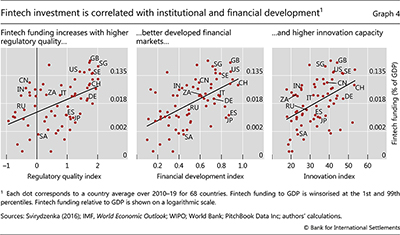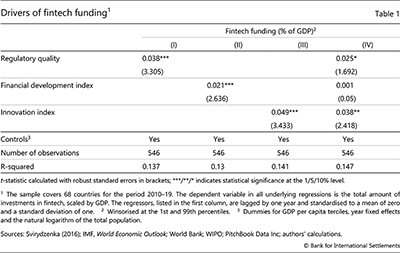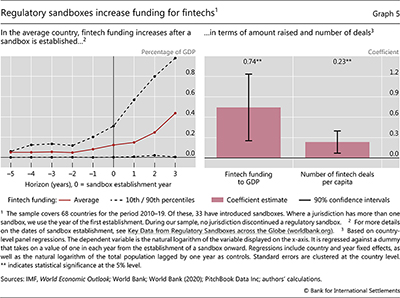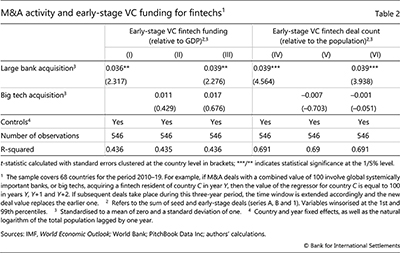Funding for fintechs: patterns and drivers

This special feature examines trends in equity funding for financial technology firms (fintechs) and the underlying country-specific drivers. Fintechs have raised over $1 trillion in equity globally since 2010. While the investment landscape was initially quite concentrated, it has become more diverse, both geographically and across market segments. Equity funding for fintechs is higher in countries with more innovation capacity and better regulatory quality. It also increases after the introduction of regulatory sandboxes. Early-stage venture capital investment is higher after merger and acquisition activity by large banks, but not after that by big techs. 1
JEL classification: E51, G23, O31.
New financial technology firms (fintechs) have proliferated over the past decade, reshaping the financial sector in economies around the world. Fintechs often target specific market segments in payments, credit, insurance or wealth management. In many cases, their growth is fuelled by risk-bearing capital.
This special feature explores patterns in fintechs' equity funding and contributes to the literature by systematically studying the underlying drivers. First, it provides an overview of investment in fintechs across time, regions, market segments and investment stages. Second, it analyses which factors are associated with differences in fintechs' capital-raising activity across countries. Third, it is among the first studies to address the questions: Can targeted policy measures, in particular regulatory sandboxes, improve fintechs' access to finance? How does venture capital (VC) investment in early-stage fintechs respond to mergers and acquisitions (M&As) involving fintechs and either large banks or large technology companies (big techs)?
The main findings are the following.
Equity investment in fintechs has expanded rapidly over the past decade, amounting to over $1 trillion in more than 35,000 deals since 2010. This growth, and especially that of VC investments, far outpaced the growth of non-fintech deals. By 2020, the capital raised by fintechs reached 5% of the value of global equity deals, up from less than 1% in 2010. This has gone hand in hand with greater geographical diversification of deals, even though the United States, the European Union (EU), the United Kingdom and China remain the main locations. A similar picture emerges in terms of market segments: while a few – such as "cryptocurrency and blockchain" and "big data, artificial intelligence (AI) and machine learning" – dominate the funding landscape, smaller segments are gaining ground.
Key takeaways
- Investment in fintechs has grown rapidly since 2010 and has been higher in countries with more capacity for innovation and better regulations.
- Fintech capital-raising activity surges after the establishment of regulatory sandboxes, a widely adopted policy tool to spur innovation in the financial sector.
- Venture capital funding for early-stage fintechs rises after merger and acquisition activity in the sector by large banks, but not by big techs.
Turning to potential drivers, we find that fintechs raise more capital in countries with better regulatory quality, higher financial development and, more specific to fintech, greater innovation capacity (see box). When we consider these factors together to parse their overall impact, it is especially innovation capacity and, to a lesser extent, regulatory quality that matter.
We also find that regulatory sandboxes – frameworks for testing financial products that use new technologies in a controlled environment – spur entry in the fintech sector.2 Over the three years after their establishment, country-level investment in fintech nearly quadruples as a share of GDP. Sandboxes, which have been adopted in almost 60 countries, could thus help to foster financial innovation – but regulators should weigh their costs and the implications of innovation for financial stability and other regulatory mandates.
Finally, we show that VC funding for early-stage fintechs increases after mergers and acquisitions (M&As) in the fintech sector that involve large banks, but not after those involving big techs. This finding suggests that, by seeking often to exploit synergies with fintechs, banks could spur fintech formation. Big techs, by contrast, which are frequently in direct competition with fintechs, might thwart fintech entry by discouraging users from joining the networks of fledgling competitors (the so-called kill zone).
The rest of the special feature is organised as follows. The first section discusses investment patterns and how these have evolved over time and space. The second develops the empirical analysis of drivers of fintech investment. The third investigates the impact of regulatory sandboxes on fintech funding, and the fourth analyses how M&A activity by large banks and big techs affects VC deals.
How has investment in fintech evolved over time?
Data on investment deals in the fintech sector come from PitchBook Data Inc, a private data provider. The deal location is classified as that of the headquarters of the firm raising the capital. PitchBook also groups firms according to market segments offering similar products and services – so-called "verticals" (see box). Examples of market segments include "cryptocurrency and blockchain", "insurtech" and "real estate and mortgage tech". The data provider also distinguishes between investment types that correspond roughly to the stages of a firm's life cycle: in their standard sequence, VC, private equity (PE), M&As and public listing.3
Investments in fintech have risen rapidly over the last decade, in terms of both number and value of deals. Meanwhile, investors have expanded across countries, market segments and deal stages. As in other sectors, there are many small deals in younger fintechs, and far fewer but larger deals in mature companies.
While total fintech deals numbered less than 600 in 2010, for a total value of around $11 billion, the total capital raised by fintechs in 2019 exceeded $218 billion, through almost 5,000 individual deals (Graph 1, left-hand panel). This trend reversed in 2020 during the Covid-19 pandemic, but investment has rebounded strongly in 2021. From a longer-term perspective, the average annual growth rate of equity raised in global fintech deals was 45% between 2010 and 2020 – much higher than the corresponding 8% growth rate for non-fintech deals. By 2020, capital raised by fintechs reached 5% of the total capital raised in global equity deals, up from less than 1% in 2010.
Capital-raising by fintechs has followed a similar upward trend in most regions. The largest market is the United States, accounting in recent years for almost 40% of the number of deals globally (and more than 50% of deal value). This is followed by the EU, the United Kingdom and China, which together account for 33% of the deals (and 35% by value). Yet the rest of the world – where India, Canada, Singapore and Australia take the lead – has increased its share over time. Calculated after grouping deals by country, the Herfindahl-Hirschman Index (HHI, a measure of concentration) declined by around 50% between 2010 and 2017, and it has shown only a modest increase since (Graph 1, left-hand panel, black line).
The relative importance of different market segments in the fintech sector has shifted over time (Graph 1, right-hand panel). Among major segments, the shares of deals by firms in "insurtech" and "real estate and mortgage tech" have remained relatively stable. By contrast, the shares of "big data, AI and machine learning" and especially "cryptocurrency and blockchain" have increased markedly. The growing importance of the latter could reflect investor interest in fintechs targeting innovations in wholesale and retail payments – such as the institutional use of blockchain, cryptoasset trading and stablecoins (BIS (2020)). The share of "e- and mobile commerce" and others has fallen. In parallel, the investment landscape has become less concentrated across market segments, as the HHI across segments has steadily declined (right-hand panel, black line). A similar decline in concentration is observed for deal values (not shown).
In terms of investments at different stages in fintechs' life cycle, VC and M&As dominate (Graph 2). The relative importance of VC funding – which usually targets younger companies – has increased over time (left-hand panel), mostly due to activity in China (right-hand panel). VC accounts for over a third of the value of all equity investment in 2021, up from 13% in 2010. The United States and United Kingdom have seen relatively more M&A investment in fintech (in line with their higher M&A activity overall). Globally, the share of M&A activity was particularly high in 2019 and 2020, amounting to 66% and 48%, respectively, of total investment values.4
Zooming in on VC deals reveals many young companies that raise relatively small amounts of equity. Together, seed (or startup) and early-stage deals have made up roughly 90% of the total number of VC deals, both over time (Graph 3, left-hand panel) and across regions (right-hand panel). However, these deals – which are usually small in value – often account for half or less of the total value of VC investment, with a few later-stage deals accounting for the rest. The relative importance of seed and early-stage deals in the total deal value declined over time, probably reflecting the fintech sector's coming of age.
Beyond highlighting general trends, detailed and timely data on investment deals could allow public authorities to gauge investor expectations of future growth in novel financial services. Private data sources add substantial value, not least because of the paucity of regulatory reporting on fintech (FSB (2017); IFC (2020)). Thus, the full data set on the volume and number of fintech deals by country and year is available online along with this special feature.5
Drivers of fintech funding
Investments in fintech vary widely across countries. For instance, while investment in fintech was less than 0.01% of GDP in Russia and Saudi Arabia in 2019, it reached 0.06% of GDP in Switzerland and close to 2% in Singapore and the United Kingdom.
To investigate potential explanations for these cross-country differences, we consider structural features of national economies: countries' regulatory quality, the depth of domestic financial markets and their innovation capacity. The specific measures are outlined in the box. Previous work highlights the importance of the rule of law and the quality of legal and regulatory institutions for investments (La Porta et al (2008); Demirgüç-Kunt and Levine (2018)). As the fintech sector is relatively young and lacks established best practices, the regulatory environment could be particularly relevant (Barba Navaretti et al (2017); Cumming and Schwienbacher (2018)). In turn, the depth of financial markets, and access to finance in general, go together with higher capital-raising activity and firm formation (Ayyagari et al (2011); Doidge et al (2013)), and may benefit fintech activities (Claessens et al (2018); Haddad and Hornuf (2019); Rau (2020); Cornelli et al (2020a)). More developed financial markets facilitate a successful matching between investors and firms and are especially important for fast-growing sectors such as fintech. In addition, and more specific to fintechs, a more innovative environment is generally conducive to the financing of startups, as positive knowledge externalities increase the returns to firm formation and innovation (McCann and Ortega-Argilés (2013); Edler and Fagerberg (2017)). Since many fintech firms rely on new technologies, such as AI and mobile technologies, a domestic research capacity in these fields may be important.
When considered individually, regulatory quality (Graph 4, left-hand panel), the depth of domestic financial markets (centre panel) and a country's innovation capacity (right-hand panel) are positively correlated with investment in fintech. Among major markets, the United States and United Kingdom rank highly on regulatory quality and financial market development, while these countries as well as several European countries and China score relatively highly on innovation capacity.
The identified relationships are robust to controlling for other characteristics of national economies, ie GDP per capita, population and changes in global conditions (Table 1). In panel regressions at the country-year level, a stronger regulatory and institutional quality is linked to higher investment from 2010 to 2019 (first column). In particular, considering two countries that are 20 positions apart in the ranking of the 68 countries in our sample, the difference between the corresponding fintech investment-to-GDP ratios is roughly 60% of the average ratio (which is 0.06% of GDP). A similar improvement in ranks along the financial development index is associated with an increase in the funding-to-GDP ratio that amounts to one third of the average level (second column).
Finally, the corresponding rise in fintech funding in the context of the innovation index is 80% of the average (third column).6
Of course, countries with better regulatory frameworks usually also have more developed financial markets and a higher innovation capacity. This implies that the results discussed so far may overstate the impact of each individual driver taken in isolation. When we jointly investigate the impact of all three structural indicators, we find that regulatory quality and especially innovative capacity have a statistically significant effect even when the influence of other factors is controlled for (fourth column).
Regulatory sandboxes and investment in fintech
To complement the analysis of structural drivers, we now turn to the effects of regulatory sandboxes on fintech investment. To spur innovation in the financial sector in the near term, nearly 60 jurisdictions have introduced a sandbox as a targeted policy measure (World Bank (2020)).7
Sandboxes provide regulators and firms with a controlled testing environment for financial products using emerging technologies. Their goal is to nurture financial innovation and competition, and they often facilitate fintechs' access to capital. Firms that enter the sandbox, and especially those that "graduate", have been judged by the regulator to offer innovative products and be able to comply with applicable rules. Sandboxes can thus improve the information available to investors and reduce regulatory uncertainty (Cornelli et al (2020b)). More generally, they can signal that authorities are inclined to support the entry of new players in the financial sector.
The establishment of a sandbox is a pivotal point for investments in the fintech sector (Graph 5, left-hand panel). Prior to the establishment of a sandbox, investments tend to be a small share of GDP. The picture changes drastically once the sandbox is in place, with the ratio of fintech investment to GDP picking up strongly already after one year. Over the three years after establishment, this ratio nearly quadruples on average, suggesting a sustained boost after initial cohorts graduate from the sandbox. This includes firms developing outside the sandbox, as investors might see greater regulatory certainty and higher growth prospects for fintechs in general.
Sandboxes are associated with an economically large and statistically significant rise in investment in fintechs even after controlling for countries' level of development and other macroeconomic characteristics (Graph 5, right-hand panel). Investment as a share of GDP is, on average, around 75% higher in the years after the establishment of a sandbox than in the years before. Similarly, the number of deals per capita increases by almost a quarter.
Admittedly, higher investment in fintech does not always lead to improvements for consumers or society, and running a regulatory sandbox does entail costs for regulators (UNSGSA FWG and CCAF (2019)). Nonetheless, taken together, these findings suggest that sandboxes can support risk-bearing investment in new firms and could become a successful tool to foster innovation.
M&A activity and VC funding
While fintech funding is growing rapidly, the innovation impetus may wane because of rising market concentration, particularly due to big techs' growth (Carstens et al (2021); Katz (2021)). If big techs acquire new entrants, this could slow innovation.
Usually, M&As by large firms spur firm entry, as acquisitions raise the potential return to entrepreneurs through higher firm valuations (Phillips and Zhdanov (2013)). In the digital economy, however, network effects imply that incumbents with a large user base have a head start over new entrants. In such markets, M&A activity could even reduce innovation. By acquiring entrants before their products reach sufficient scale, big techs can discourage users from joining these entrants' network, thereby reducing startups' growth prospects. For big techs in the US, this "kill zone" effect has been shown to make it harder for innovative firms to raise capital (Kamepalli et al (2020)). Relatedly, large firms may engage in "killer acquisitions" to discontinue a target firm's innovation projects (Cunningham et al (2021)). Whether acquisitions by large banks – which may see fintechs as complementing their existing services, rather than as direct competitors – have a different effect remains an open question.
Further reading
We find a major difference between the effects of banks and big techs. M&As by large banks spur seed and early-stage VC investment in the fintech sector – the main source of funding for young firms – while M&As by big techs do not (Table 2). Acquisitions by large banks usher in significantly higher early-stage VC investment in the country of the acquired company (first column). In the three years after such acquisitions, early-stage VC investments as a share of GDP are 30% higher than their long-term average. Big tech acquisitions do not lead to similar effects (second column). The results are robust to considering large bank and big tech M&A activity simultaneously (third column) and to using the number of VC deals relative to the population as a measure of fintech investment (fourth to sixth columns).
This difference could reflect the relative importance of network effects for big techs, fintechs and banks. Both big tech and fintech business models depend on building up a large network of users through digital platforms. Big techs may thus see fintech entrants as direct competitors. Banks, by contrast, tend to have a more stable client base that is often based on long-term relationships, and may see fintech products and services as complementary to their existing offerings.
All said, these results suggest that authorities need to remain vigilant to competition in the fintech sector. Greater investment, and particularly early-stage VC investment, has been shown to foster firm creation and patent activity (Lerner and Nanda (2020)). This can, in turn, support innovation and competition, enhancing financial inclusion (Philippon (2017)). Yet abuse of market power could distort markets and slow beneficial innovation. It will be important to study further how M&A activity affects funding for new firms, and how financial regulation should interact with competition policy.
Conclusion
Investors have ramped up their funding of fintechs since 2010, and VC funding in particular has grown. While overall investment was initially quite concentrated in a few large markets and segments, the funding landscape has become more diverse.
Investment in fintechs responds to structural features of national economies –such as higher innovation capacity and better regulatory quality – as well as targeted policy measures in the form of regulatory sandboxes. The results also suggest that M&As by large banks go hand in hand with more investment in young fintechs, while M&As by big techs do not.
Our analysis can help to inform policy on how to spur and monitor innovation in the financial sector. The positive impacts of the quality of regulation and of targeted initiatives like sandboxes suggest that policy can play a role to promote innovation. Yet regulators need to monitor developments to ensure that innovation in the financial sector serves the public interest.
References
Ayyagari, M, A Demirgüç-Kunt and V Maksimovic (2011): "Firm innovation in emerging markets: The role of finance, governance, and competition", Journal of Financial and Quantitative Analysis, vol 46, issue 6, pp 1545–80.
Barba Navaretti, G, G Calzolari, J M Mansilla-Fernandez and A F Pozzolo (2017): "FinTech and banks: friends or foes?", European Economy: Banks, Regulation, and the Real Sector, year 3, issue 2.
Bank for International Settlements (BIS) (2020): "Central banks and payments in the digital era", BIS Annual Economic Report, June.
Carstens, A, S Claessens, F Restoy and H S Shin (2021): "Regulating big techs in finance", BIS Bulletin, no 45, August.
Cunningham, C, F Ederer and S Ma (2021): "Killer acquisitions", Journal of Political Economy, vol 129, no 3, pp 649–702.
Claessens, S, J Frost, G Turner and F Zhu (2018): "Fintech credit markets around the world: size, drivers and policy issues", BIS Quarterly Review, September, pp 29–49.
Cornelli, G, J Frost, L Gambacorta, R Rau, R Wardrop and T Ziegler (2020a): "Fintech and big tech credit: a new database", BIS Working Papers, no 887, September.
Cornelli, G, S Doerr, L Gambacorta and O Merrouche (2020b): "Inside the regulatory sandbox: effects on fintech funding", BIS Working Papers, no 901, November.
Cumming, D J and A Schwienbacher (2018): "Fintech venture capital", Corporate Governance: An International Review, vol 26, issue 5, pp 374–89.
Demirgüç-Kunt, A and R Levine (2018): Finance and Growth, Edward Elgar.
Doidge, C, A Karolyi and R Stulz (2013): "The U.S. left behind? Financial globalization and the rise of IPOs outside the U.S.", Journal of Financial Economics, vol 110, no 3, pp 546–73.
Financial Stability Board (FSB) (2017): Financial Stability Implications from FinTech Supervisory and Regulatory Issues that Merit Authorities' Attention, 27 June.
Edler, J and J Fagerberg (2017): "Innovation policy: what, why, and how", Oxford Review of Economic Policy, vol 33 issue 1, pp 2–23.
Haddad, C and L Hornuf (2019): "The emergence of the global fintech market: economic and technological determinants", Small Business Economics, vol 53, no 1, pp 81–105.
Irving Fisher Committee (IFC) (2020): "Central banks and fintech data issues", IFC Report, no 10, February.
Kamepalli, S K, R Rajan and L Zingales (2020): "Kill zone", NBER Working Paper, no 27146.
Katz, M (2021): "Big Tech mergers: Innovation, competition for the market, and the acquisition of emerging competitors", Information Economics and Policy, vol 54.
La Porta, R, F Lopez-de-Silanes and A Shleifer (2008): "The economic consequences of legal origins", Journal of Economic Literature, vol 46(2), pp 285–332.
Lerner, J and R Nanda (2020): "Venture capital's role in financing innovation: What we know and how much we still need to learn", Journal of Economic Perspectives, vol 34, issue 3, pp 237–61.
McCann, P and R Ortega-Argilés (2013): "Modern regional innovation policy", Cambridge Journal of Regions, Economy and Society, vol 6, issue 2, pp 187–216.
Phillips, G and A Zhdanov (2013): "R&D and the incentives from merger and acquisition activity", The Review of Financial Studies, vol 26, no 1, pp 34–78.
Philippon, T (2017): "The fintech opportunity", BIS Working Papers, no 655.
Rau, R (2020): "Law, trust, and the development of crowdfunding", working paper.
Svirydzenka, K (2016): "Introducing a new broad-based index of financial development", IMF Working Paper, no 16/5.
United Nations Secretary General's Special Advocate for Inclusive Finance for Development (UNSGSA) FinTech Working Group (FWG) and Cambridge Centre for Alternative Finance (CCAF) (2019): Early Lessons on Regulatory Innovations to Enable Inclusive FinTech: Innovation Offices, Regulatory Sandboxes, and RegTech, Office of the UNSGSA and CCAF.
World Bank (2020): Key Data from Regulatory Sandboxes across the Globe, November.
Zhang, D, S Mishra, E Brynjolfsson, J Etchemendy, D Ganguli, B Grosz, T Lyons, J Manyika, J C Niebles, M Sellitto, Y Shoham, J Clark and R Perrault (2021): The AI Index 2021 Annual Report, AI Index Steering Committee, Human-Centered AI Institute, Stanford University, March.
1 We thank Viviana Alfonso, Sirio Aramonte, Raphael Auer, Ryan Banerjee, Claudio Borio, Stijn Claessens, Leonardo Gambacorta, Benoît Mojon, Hyun Song Shin and Nikola Tarashev for comments. The views expressed in this article are those of the authors and do not necessarily reflect those of the Bank for International Settlements.
2 See FSB (2017) and Cornelli et al (2020b).
3 The typical life cycle of a fintech is similar to that of firms in other sectors. Startups typically rely on seed VC funding to develop a product. They use additional, early-stage VC and PE investment to scale up and serve a growing customer base. Once firms have achieved positive cash flow and profitability, VC and PE investors can sell their equity stake or "exit" through M&A, initial public offerings, etc. Our data set covers investment at each of these stages.
4 In 2021, meanwhile, there was relatively strong investment in publicly listed fintech companies, driven by a spate of large initial public offerings and special purpose acquisition companies.
5 See https://www.bis.org/publ/qtrpdf/r_qt2109c_data.xlsx.
6 Regression results are qualitatively similar when we use sub-indices of financial development that measure the development of financial markets vs financial institutions, scale the dependent variable by overall investment, or control for GDP growth or the log of mobile subscriptions. Moreover, similar results hold when we use the rule of law, bank credit to GDP and artificial intelligence conference papers per capita (Zhang et al (2021)) as alternative independent variables.
7 Regulatory sandboxes are one form of innovation facilitators. Other forms include innovation hubs, which often involve dedicated support to supervised firms within existing regulatory frameworks, and accelerators, which may entail awarding grants to or buying services from innovative firms.

